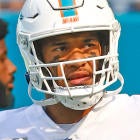
Tua Tagovailoa is out indefinitely after suffering at least his second concussion of the 2022 NFL season. Now the NFL Players Association is initiating another investigation into the quarterback's latest injury, according to CBS Sports NFL insider Jonathan Jones. So why didn't Tagovailoa exit last Sunday's loss to the Packers, in which he sustained the hard hit that presumably led to the head injury? The reason is twofold, per Dr. Allen Sills, the NFL's chief medical officer: Tagovailoa didn't display any immediate symptoms, and he didn't report any to team doctors.
"What our spotters and our unaffiliated neuro doctors are looking for is any blow that transmits force to the head or neck area, followed by that injury behavior," Sills told NFL Media's Judy Battista this week. "There are many blows to the head that occur during a game. We are always looking for the blow plus the injury behavior, and obviously if we see any injury behavior, then there's a call down made to evaluate that player.
"Also, if a player identifies any symptoms or a teammate, coach, official, anyone else identifies symptoms," Sills continued, "that also initiates a protocol. So many people can initiate the protocol and in this game on Sunday, none of those factors were present. There were no visible signs present, even though there was a blow to the head and the player did not report any symptoms, despite being in contact with the medical staff throughout the game. So, there was nothing that would have triggered the protocol in the moment."
Tagovailoa, who was hospitalized earlier this season for an additional head injury, played Sunday's entire game, throwing three second-half interceptions in a 26-20 defeat, despite his head slamming to the ground on a second-quarter hit. The QB reported concussion symptoms to the team a day later, requiring a return to protocol, which must be cleared before a return to game action. It's not uncommon for players to report symptoms on a delayed basis, Sills added.

Pick Six Newsletter
Crafted By The Best NFL Experts
Get the day's big stories + fun stuff you love like mock drafts, picks and power rankings.
Thanks for signing up!
Keep an eye on your inbox.
Sorry!
There was an error processing your subscription.
Is it possible the NFL's protocol is not sufficient, given Tagovailoa already had a history of head trauma entering Sunday's game? Sills left the door open for additional changes and improvements to the protocol, but also suggested players are ultimately part of the decision-making process when it comes to risking further injury.
"In any case of this nature, the team is going to behave in a very conservative manner," Sills said. "They're going to gather all the data. They're going to make sure the athlete goes through all of those steps. Sometimes they'll even seek outside opinions about that. And then they'll do what we do every day in medicine, which is they'll sit down with the athlete, and they'll explain to him the situation and allow that athlete to have a voice in that decision-making. Because at the end of the day, our protocol is to make sure that the athlete appears to be recovered, but we still with today's technology can't really estimate that risk of future injury. And so what we have to do is make sure the athlete is fully recovered and then make sure that their voice and their autonomy is respected in this decision-making process."

















